Abstract
The potential of octenidine hydrochloride (WIN 41464-2) as a topical microbicide was measured both by in vitro death kinetics and reductions in numbers of bacteria on the skin of cynomolgus monkeys. Semilogarithmic survival curves were plotted to measure the microbicidal activity of various concentrations of octenidine against Staphylococcus aureus. The microbicidal activity of octenidine was also determined for Staphylococcus epidermidis, Proteus mirabilis, Streptococcus pyogenes, Klebsiella pneumoniae, Escherichia coli, Pseudomonas aeruginosa, Serratia marcescens, and Candida albicans. Death rates for the same microbial strains were compared with those obtained by using chlorhexidine gluconate. Octenidine concentrations of less than 1.5 microM (0.94 microgram/ml) caused a greater than 99% reduction of each microbial population within 15 min. Staphylococcus epidermidis was the most susceptible of the test organisms, and E. coli and C. albicans were the least susceptible. Octenidine was more active than chlorhexidine against each test strain. Skin-degerming activities of aqueous and formulated octenidine and formulated chlorhexidine were compared in single and multiple applications of these agents to the hand and foot surfaces of monkeys by using a glove-juice extraction procedure to measure the skin microflora. Aqueous octenidine, at a concentration of 0.2 to 1.6% reduced resident microflora populations from 90 to 99.98%, depending on the concentration and number of applications. Octenidine formulated at 2% in a surfactant-based vehicle exhibited significantly better skin-degerming activity than did either a nonmedicated vehicle or the Hibiclens brand of 4% chlorhexidine gluconate.
Full text
PDF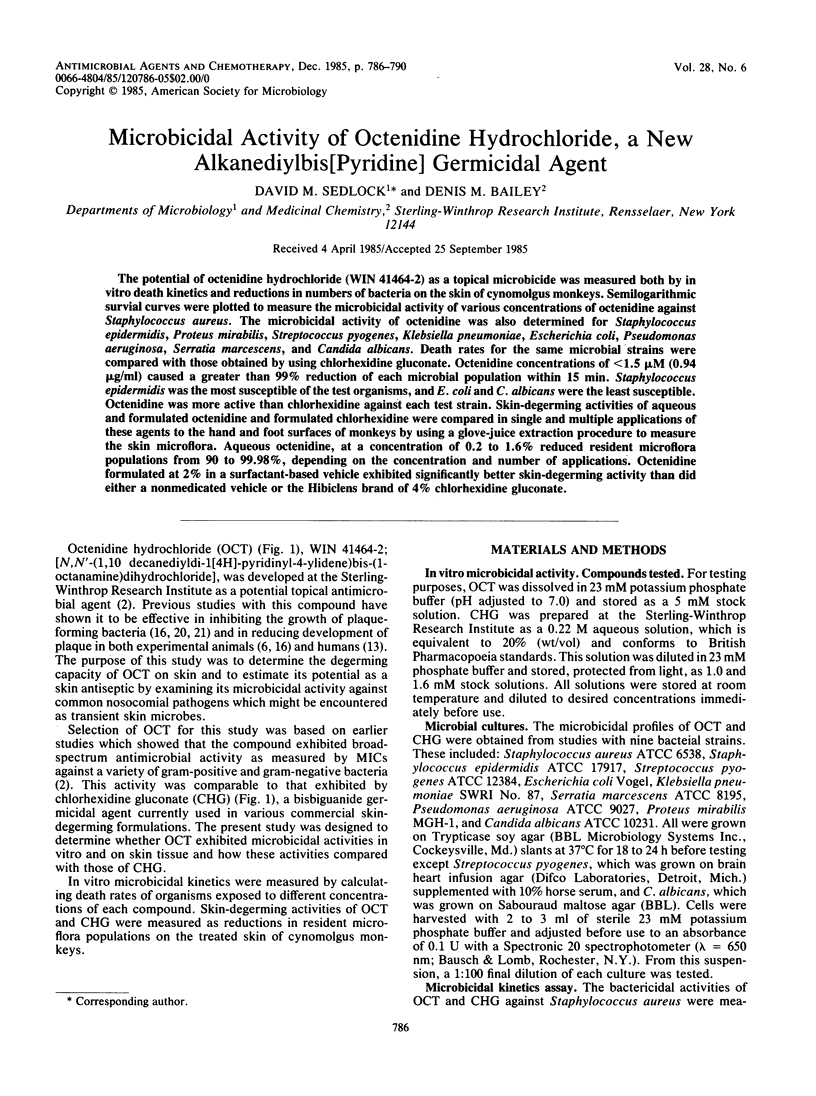
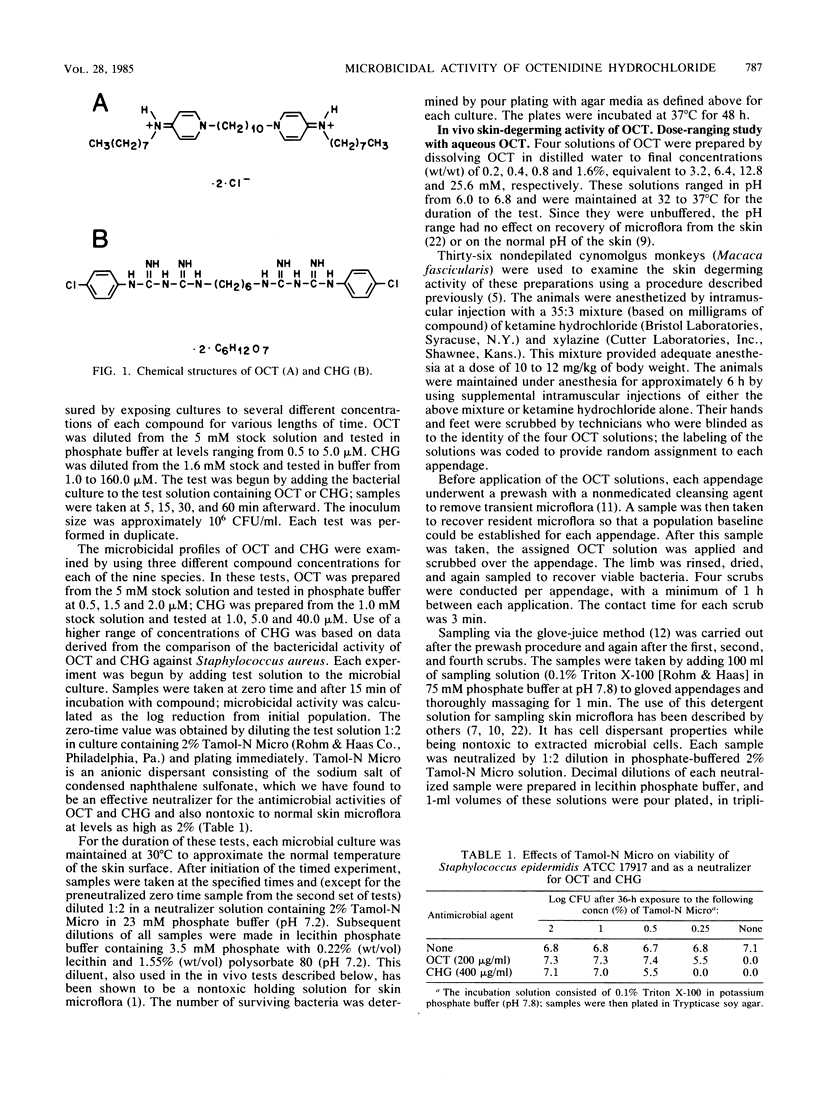
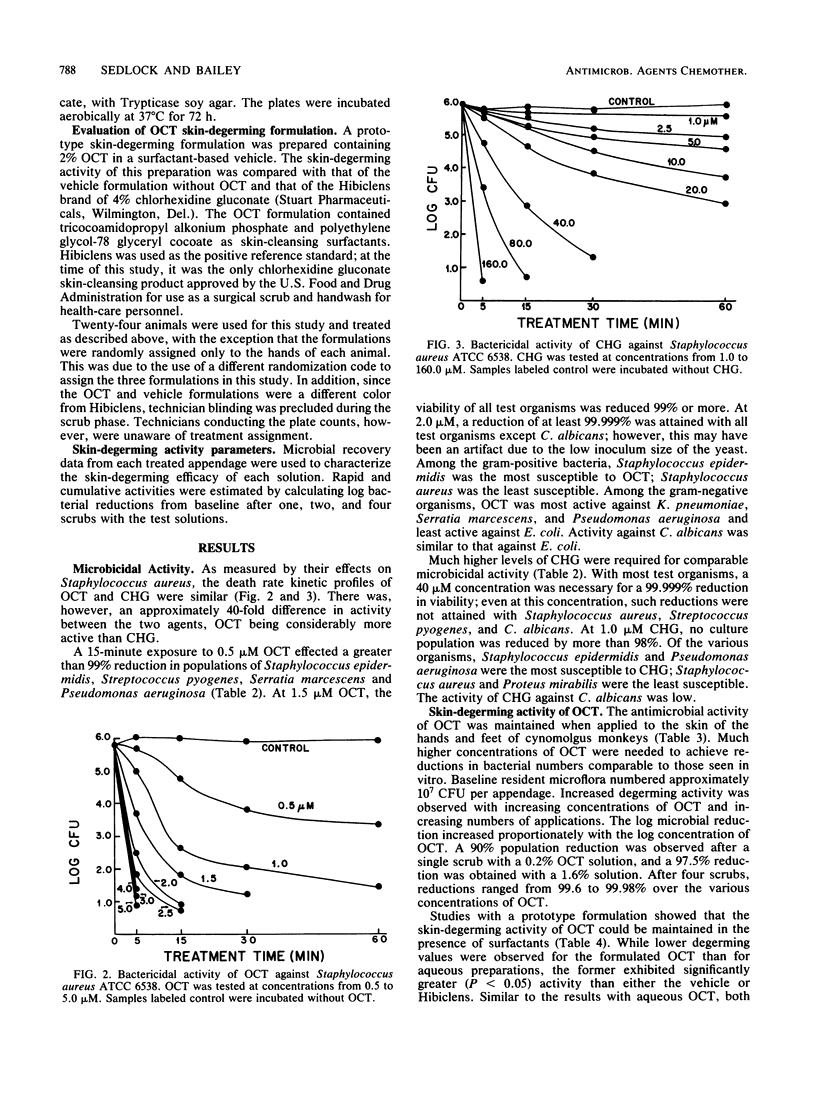
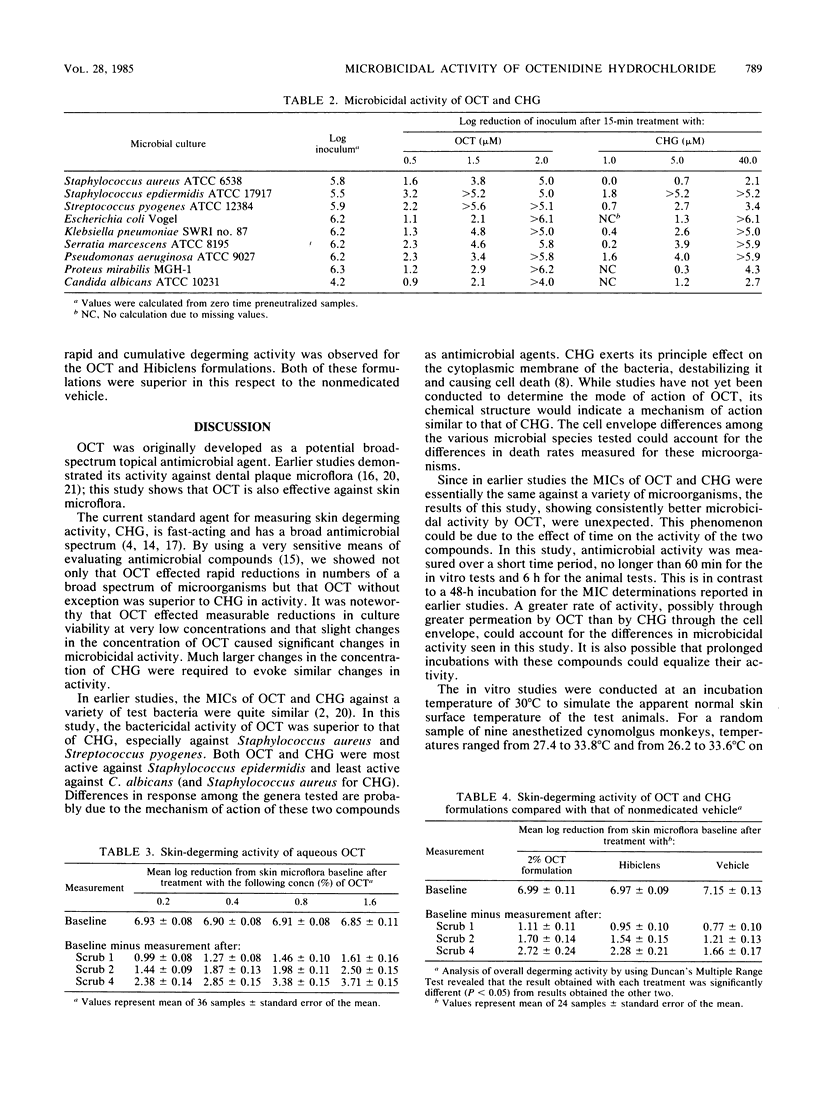
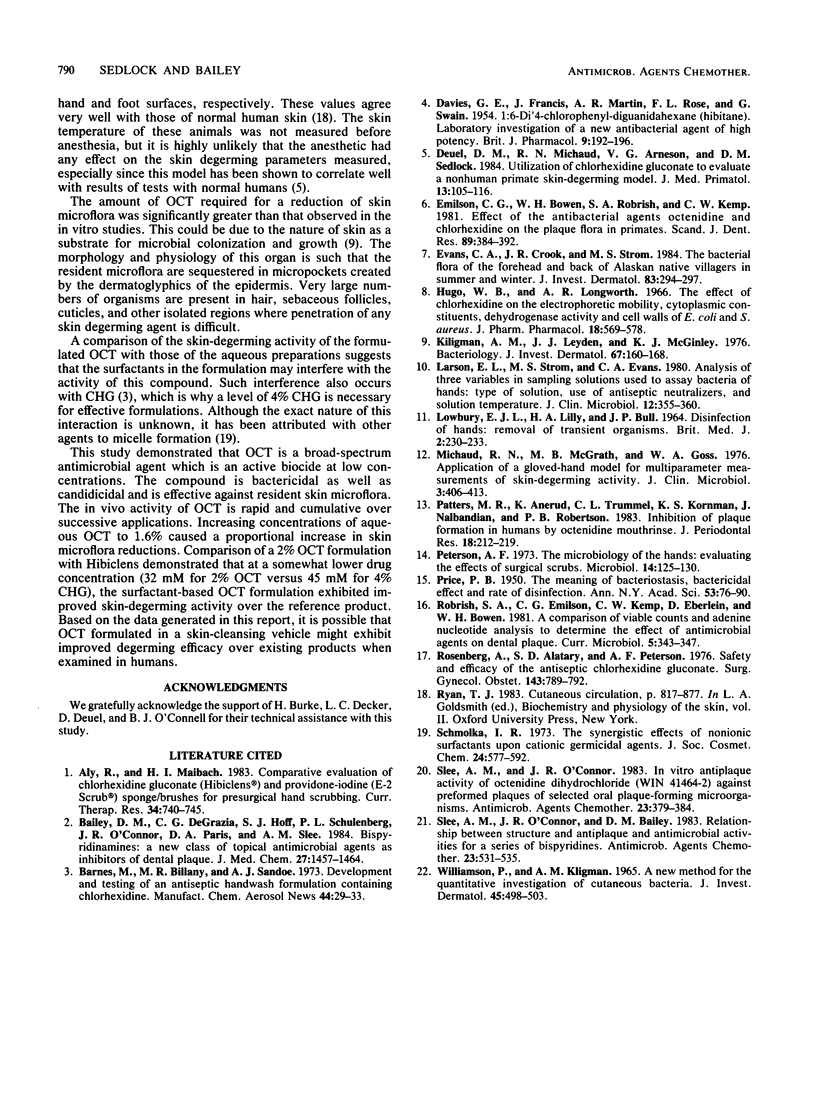
Selected References
These references are in PubMed. This may not be the complete list of references from this article.
- Bailey D. M., DeGrazia C. G., Hoff S. J., Schulenberg P. L., O'Connor J. R., Paris D. A., Slee A. M. Bispyridinamines: a new class of topical antimicrobial agents as inhibitors of dental plaque. J Med Chem. 1984 Nov;27(11):1457–1464. doi: 10.1021/jm00377a014. [DOI] [PubMed] [Google Scholar]
- DAVIES G. E., FRANCIS J., MARTIN A. R., ROSE F. L., SWAIN G. 1:6-Di-4'-chlorophenyldiguanidohexane (hibitane); laboratory investigation of a new antibacterial agent of high potency. Br J Pharmacol Chemother. 1954 Jun;9(2):192–196. doi: 10.1111/j.1476-5381.1954.tb00840.x. [DOI] [PMC free article] [PubMed] [Google Scholar]
- Deuel D. M., Michaud R. N., Arneson V. G., Sedlock D. M. Utilization of chlorhexidine gluconate to evaluate a nonhuman primate skin-degerming model. J Med Primatol. 1984;13(2):105–116. [PubMed] [Google Scholar]
- Emilson C. G., Bowen W. H., Robrish S. A., Kemp C. W. Effect of the antibacterial agents octenidine and chlorhexidine on the plaque flora in primates. Scand J Dent Res. 1981 Oct;89(5):384–392. doi: 10.1111/j.1600-0722.1981.tb01697.x. [DOI] [PubMed] [Google Scholar]
- Evans C. A., Crook J. R., Strom M. S. The bacterial flora of the forehead and back of Alaskan native villagers in summer and in winter. J Invest Dermatol. 1984 Mar;82(3):294–297. doi: 10.1111/1523-1747.ep12260391. [DOI] [PubMed] [Google Scholar]
- Hugo W. B., Longworth A. R. The effect of chlorhexidine on the electrophoretic mobility, cytoplasmic constituents, dehydrogenase activity and cell walls of Escherichia coli and Staphylococcus aureus. J Pharm Pharmacol. 1966 Sep;18(9):569–578. doi: 10.1111/j.2042-7158.1966.tb07935.x. [DOI] [PubMed] [Google Scholar]
- Kligman A. M., Leyden J. J., McGinley K. J. Bacteriology. J Invest Dermatol. 1976 Jul;67(1):160–168. doi: 10.1111/1523-1747.ep12513007. [DOI] [PubMed] [Google Scholar]
- LOWBURY E. J., LILLY H. A., BULL J. P. DISINFECTION OF HANDS: REMOVAL OF TRANSIENT ORGANISMS. Br Med J. 1964 Jul 25;2(5403):230–233. doi: 10.1136/bmj.2.5403.230. [DOI] [PMC free article] [PubMed] [Google Scholar]
- Larson E. L., Strom M. S., Evans C. A. Analysis of three variables in sampling solutions used to assay bacteria of hands: type of solution, use of antiseptic neutralizers, and solution temperature. J Clin Microbiol. 1980 Sep;12(3):355–360. doi: 10.1128/jcm.12.3.355-360.1980. [DOI] [PMC free article] [PubMed] [Google Scholar]
- Michaud R. N., McGrath M. B., Goss W. A. Application of a gloved-hand model for multiparameter measurements of skin-degerming activity. J Clin Microbiol. 1976 Apr;3(4):406–413. doi: 10.1128/jcm.3.4.406-413.1976. [DOI] [PMC free article] [PubMed] [Google Scholar]
- PRICE P. B. The meaning of bacteriostasis, bactericidal effect, and rate of disinfection. Ann N Y Acad Sci. 1950 Aug;53(1):76–90. doi: 10.1111/j.1749-6632.1950.tb31934.x. [DOI] [PubMed] [Google Scholar]
- Patters M. R., Anerud K., Trummel C. L., Kornman K. S., Nalbandian J., Robertson P. B. Inhibition of plaque formation in humans by octenidine mouthrinse. J Periodontal Res. 1983 Mar;18(2):212–219. doi: 10.1111/j.1600-0765.1983.tb00354.x. [DOI] [PubMed] [Google Scholar]
- Rosenberg A., Alatary S. D., Peterson A. F. Safety and efficacy of the antiseptic chlorhexidine gluconate. Surg Gynecol Obstet. 1976 Nov;143(5):789–792. [PubMed] [Google Scholar]
- Slee A. M., O'Connor J. R., Bailey D. M. Relationship between structure and antiplaque and antimicrobial activities for a series of bispyridines. Antimicrob Agents Chemother. 1983 Apr;23(4):531–535. doi: 10.1128/aac.23.4.531. [DOI] [PMC free article] [PubMed] [Google Scholar]
- Slee A. M., O'Connor J. R. In vitro antiplaque activity of octenidine dihydrochloride (WIN 41464-2) against preformed plaques of selected oral plaque-forming microorganisms. Antimicrob Agents Chemother. 1983 Mar;23(3):379–384. doi: 10.1128/aac.23.3.379. [DOI] [PMC free article] [PubMed] [Google Scholar]
- Williamson P., Kligman A. M. A new method for the quantitative investigation of cutaneous bacteria. J Invest Dermatol. 1965 Dec;45(6):498–503. doi: 10.1038/jid.1965.164. [DOI] [PubMed] [Google Scholar]


